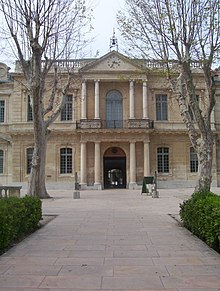Jean-Baptiste Franque
He probably trained with the great Avignon architects of the previous generation, Pierre II Mignard and Jean Péru.
He worked under the supervision of two of his sons, François II and Jean-Pierre, mainly in the south of France, from Toulon to Carcassonne, passing through Viviers where they made the vaults of the cathedral.
Thus, François, who had attended the French School in Rome and was a member of the Royal Academy of Architecture in Paris, was the co-author of the palace of Villeneuve-Martignan (today's Musée Calvet), the palace of Caumont, the church of Notre-Dame des Pommiers in Beaucaire and the central portal of the Saint Martha's hospital, which is now the seat of the University of Avignon.
[3] Jean-Baptiste Franque marked the regional architecture, realizing the synthesis between the local tradition with Italian tendency, of which Jean Péru was the continuator, and the French classicism, established in Avignon by Pierre II Mignard.
Franque's domination and knowledge of stereotomy allowed him to cover a large number of works with daring vaults, with an inventive structure; he also tried to create suspended staircases, whose supporting structure were the steps themselves, but the technique would be perfected only half a century later by Victor Louis.



